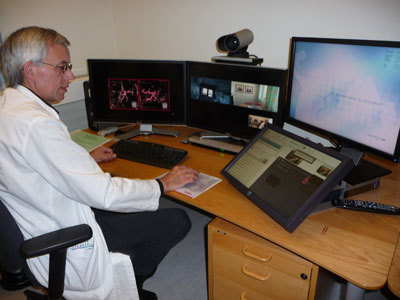Telestroke in Nordland Hospital
Improved treatment of cerebral stroke patients in small hospitals.
Telestroke implies that the stroke specialist examines the patient through video- and sound communication in cooperation with the doctor at the local site. Radiology images are transmitted using the RIS/PACS system.
The aim of this project is to study a telestroke service implemented in the Nordland Hospital: how it may influence the treatment of stroke patients and the organisational and technological requirements for the service.

Background
Cerebral stroke is the third most frequent cause of death in Norway and the most common cause of severe disability in adults. The annual incidence is about three per 1,000 inhabitants.
Hospitalization in a specialized stroke unit leads to a 10 % absolute reduction in mortality in the acute phase, and a similar reduction in the proportion of patients who can manage without help one year after the stroke incidence. The prognosis for patients with ischemic stroke is further improved by thrombolysis treatment in the acute phase. The challenge is the narrow time window: Thrombolysis should be given as soon as possible and not later than 4.5 hours after the first symptoms. In Norway, approximately 2% of all stroke patients receive thrombolysis, whereas 20 % is expected to benefit from such treatment (Helsedirektoratet, 2010). The low rate could be due to geographical conditions with long travel distances, lack of awareness in the population, but also little experience with the treatment in local hospitals may play a role.
Telestroke consultations are useful to assess the patients and to give decision support to decide whether patients shall have thrombolysis, as well as assessing the need for advanced specialist neurological or neurosurgical emergency treatment, supporting quick triaging and transfer to the appropriate unit.
In 2010 Helse Nord established a telemedicine service for the diagnosis and treatment of stroke patients in the Hospital Nordland, connecting the local hospitals in Lofoten and Vesterålen to the Neurology department in Bodø with high quality Videoconferencing equipment. Telestroke implies that the stroke specialist in Bodø examines the patient in cooperation with the doctor on the local site. Radiology images are transmitted using the RIS/PACS system.
Project description
The Nordland Hospital has the responsibility for the Telestroke service, while the Norwegian centre for integrated health and telemedicine (NST) has the main responsibility for the research project. The research questions will be approached from medical, organisational and technological perspectives.The clinical part of the project is led by Prof. Dr. med Rolf Salvesen and Medical advisor Ellen Rygh. The organisational parts of the project are led by PhD Kari Dyp, the technological by PhD-student Terje Solvoll and the statistical analysis by PhD Stein Olav Skrøvseth. Project manager is Heidi Jacobsen, NST.
Purpose and objectives
The purpose of the project is to study the influence of this telestroke service on the treatment of the patients, and the organizational and technological conditions for the service to be useful.
Four scientific papers will be produced, as well as a proposed model for a telestroke service in the Helse Nord Region.
Project partners
The project is a cooperative partnership between The Norwegian center for integrated health and telemedicine (NST) and the Nordland Hospital HF.
Funding
Helse Nord Regional Health Authority’s research funding.
Contact
NST: Tove Sørensen, tel +47 911 95 696, e-mail: email hidden; JavaScript is required.
Nordlandssykehuset HF: Rolf Salvesen, tel +47 481 57 900, e-mail:email hidden; JavaScript is required.
Related information (in Norwegian)
Project report: Utprøving av teleslag ved Nordlandssykehuset. NST-report 01-2011
Helse Nord News nr. 5-2011: - Alle må ha slagenheter http://www.helse-nord.no/helse-nord-nytt/alle-maa-ha-slagenheter-article86086-1526.html